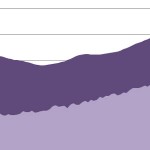Maybe the U.S. Isn’t Doing So Badly
Noting that populists on the Left and the Right tend to emphasize an unequal distribution of economic growth over the last half-century or so, James Pethokoukis reminds us that we should have a healthy suspicion of the numbers that get us to that conclusion:
A University of Chicago poll of top economists found that 70 percent agreed with the proposition that the Census Bureau’s conclusion “substantially understates how much better off people in the median American household are now economically, compared with 35 years ago.” The economist Martin Feldstein, for instance, argues that the agency fails to take into account shrinking household size, the rise in government-benefit transfers, and changes in tax policy. It also measures inflation in a way many experts think overstates the actual rise in living costs.
Depending how many of the adjustments one is willing to make, incomes for the population at large and for broad income categories, as well, have gone up by multiples of the rate that we often hear. Since the ’70s, middle-income families have seen an increase of 42%, and the lowest-income group has seen an increase of 70%. To the extent the middle class is shrinking, writes Pethokoukis, it’s because they’re moving up.
[box type=”tick” style=”rounded”]Please consider a voluntary, tax-deductible subscription to keep the Current growing and free.[/box]
Even that doesn’t account for economic mobility and, as Pethokoukis highlights, the real improvements in everybody’s lives:
The idea that most Americans are worse off than they were in the 1970s seems intuitively nonsensical to those of us who were living back then. As former Obama economic adviser Jason Furman once put it: “ignore the statistics for a second and use your common sense. Remember when even upper-middle-class families worried about staying on a long distance call for too long?
When I went to college, I created real financial hardship for myself calling a girlfriend back home, and I brought with me a 20-inch black-and-white TV that picked up a handful of stations and was connected to a junkie VHS player. To be sure, the TV was kind of antiquated technology by that point, but not laughably so.
What would be the parallel for a similarly situated student these days? Only a seven-inch generic Android tablet, maybe — connected to the campus’s free WiFi, and with a Netflix subscription, providing the student with unimaginable entertainment and information options?


